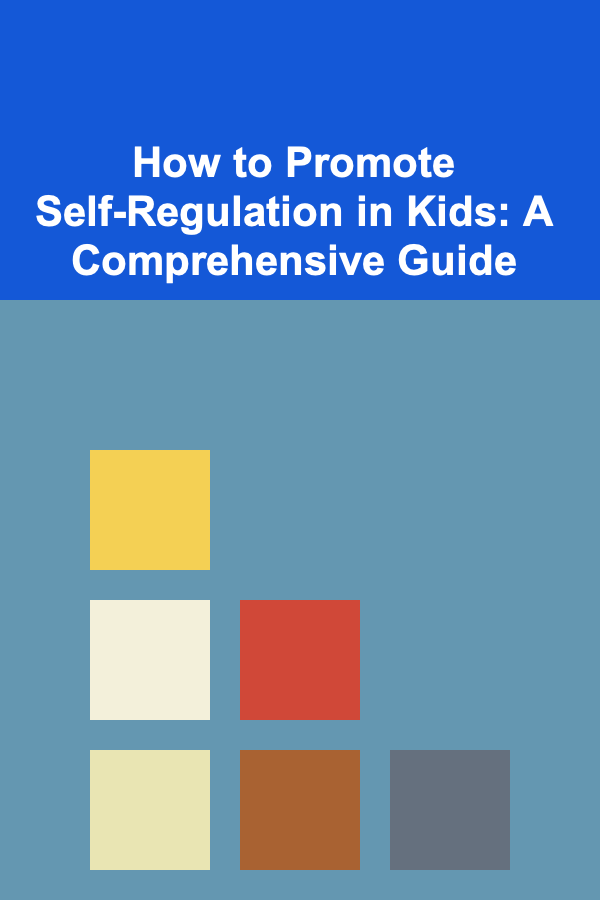
How to Promote Self-Regulation in Kids: A Comprehensive Guide
ebook include PDF & Audio bundle (Micro Guide)
$12.99$9.99
Limited Time Offer! Order within the next:

Self-regulation, often described as the ability to manage one's emotions, thoughts, and behaviors effectively in different situations, is a cornerstone of child development and future success. It's not an innate trait but rather a set of skills that are learned and refined over time. Children who develop strong self-regulation skills are better equipped to handle stress, control impulses, focus attention, and achieve their goals. This guide explores the multifaceted nature of self-regulation and provides practical strategies for parents, educators, and caregivers to nurture its development in children.
Understanding Self-Regulation
Before diving into strategies, it's crucial to understand what self-regulation truly entails. It's more than just "being good" or "following the rules." It's a complex interplay of cognitive, emotional, and behavioral processes. Think of it as the child's internal control system, allowing them to navigate the world with intention and purpose.
Key Components of Self-Regulation
- Emotional Regulation: The ability to understand, manage, and express emotions appropriately. This includes recognizing one's own feelings, understanding how they impact behavior, and developing coping mechanisms to deal with challenging emotions like frustration, anger, and sadness.
- Cognitive Regulation: The ability to focus attention, plan, organize, and problem-solve. This involves executive functions like working memory, inhibitory control (the ability to resist impulses), and cognitive flexibility (the ability to adapt to changing situations).
- Behavioral Regulation: The ability to control impulses, delay gratification, and follow through on tasks. This is often the most visible aspect of self-regulation and is directly linked to emotional and cognitive regulation.
These three components are interconnected and work together to enable a child to respond adaptively to different situations. A child struggling with emotional regulation, for example, might have difficulty focusing in class (cognitive regulation) and may act out impulsively (behavioral regulation).
Why is Self-Regulation Important?
The benefits of strong self-regulation skills are far-reaching and impact nearly every aspect of a child's life:
- Academic Success: Children with good self-regulation skills tend to perform better in school. They can focus on tasks, follow instructions, and persist through challenges.
- Social and Emotional Well-being: Self-regulation allows children to build and maintain positive relationships, manage conflict constructively, and navigate social situations with confidence. They are better able to understand and respond to the emotions of others (empathy).
- Mental Health: Difficulties with self-regulation can contribute to anxiety, depression, and other mental health issues. Conversely, strong self-regulation skills can act as a buffer against stress and adversity.
- Physical Health: Research suggests a link between self-regulation and healthy behaviors, such as eating well, exercising, and getting enough sleep.
- Future Success: Self-regulation skills are essential for success in adulthood, in both personal and professional life. They are crucial for managing finances, maintaining relationships, and achieving long-term goals.
Strategies for Promoting Self-Regulation
Promoting self-regulation in children is an ongoing process that requires patience, consistency, and a supportive environment. Here are some evidence-based strategies that can help:
1. Modeling Self-Regulation
Children learn by observing the adults around them. One of the most powerful ways to teach self-regulation is to model it yourself. This means demonstrating how you manage your own emotions, thoughts, and behaviors in a healthy way.
- Be mindful of your own reactions: How do you respond to stress, frustration, or disappointment? Do you yell, withdraw, or find constructive ways to cope? Think about how your reactions are perceived by your child.
- Talk about your feelings: Verbally express your emotions in a calm and age-appropriate manner. "I'm feeling frustrated right now because I'm stuck in traffic, but I'm going to take some deep breaths to calm down."
- Demonstrate problem-solving skills: When faced with a challenge, talk through your thought process. "I have a problem with this project. Let's break it down into smaller steps and see if that helps."
- Practice self-care: Show your child that you prioritize your own well-being. This could involve exercising, reading, spending time in nature, or engaging in hobbies.
For example, if you are running late for an appointment, instead of yelling at your child, take a deep breath and say, "Okay, we're running late. Let's see how quickly we can get ready and get out the door."
2. Creating a Predictable and Supportive Environment
Children thrive in environments that are predictable, consistent, and supportive. This helps them feel safe and secure, which reduces stress and makes it easier for them to regulate their emotions and behaviors.
- Establish routines: Consistent daily routines provide structure and predictability. This can include routines for bedtime, mealtimes, homework, and playtime.
- Set clear expectations: Children need to know what is expected of them. Clearly communicate rules and expectations in a way that is age-appropriate and easy to understand.
- Provide consistent consequences: When rules are broken, provide consistent and fair consequences. These consequences should be proportionate to the misbehavior and delivered calmly and respectfully.
- Offer unconditional love and support: Let your child know that you love and accept them regardless of their behavior. This creates a safe space for them to express their emotions and learn from their mistakes.
A consistent bedtime routine might involve taking a bath, reading a story, and then turning off the lights at the same time each night. This helps the child prepare for sleep and reduces bedtime struggles.
3. Teaching Emotional Literacy
Emotional literacy is the ability to understand and express emotions effectively. It's a fundamental skill for self-regulation, as children cannot manage emotions they don't understand.
- Help children identify their feelings: Use emotion words to describe what your child is feeling. "You seem angry." "You look sad."
- Validate their emotions: Let your child know that their feelings are valid, even if you don't agree with their behavior. "It's okay to feel angry, but it's not okay to hit your brother."
- Teach emotional vocabulary: Expand your child's emotional vocabulary by introducing them to a wide range of emotion words. Use books, games, and everyday conversations to teach about different emotions.
- Discuss the connection between feelings, thoughts, and behaviors: Help children understand how their thoughts and feelings influence their behavior. "When you think you can't do something, you might feel frustrated, and then you might give up."
Using a feelings chart with different faces depicting various emotions can help younger children identify and label their feelings.
4. Promoting Problem-Solving Skills
Problem-solving skills are essential for self-regulation because they enable children to find constructive solutions to challenges, rather than reacting impulsively.
- Teach a problem-solving process: Help children learn a structured approach to problem-solving, such as:
- Identify the problem.
- Brainstorm possible solutions.
- Evaluate the pros and cons of each solution.
- Choose the best solution.
- Try the solution.
- Evaluate the results.
- Encourage children to come up with their own solutions: Resist the urge to immediately solve problems for your child. Instead, ask them questions to guide them towards finding their own solutions. "What do you think you could do to solve this?"
- Provide support and guidance: Offer support and guidance as needed, but avoid taking over. Let your child take ownership of the problem-solving process.
- Celebrate successes: Acknowledge and celebrate your child's efforts to solve problems, even if they don't always succeed.
If two children are arguing over a toy, you could ask them, "What are some ways you could solve this problem?" Guide them to brainstorm solutions like taking turns, sharing the toy, or finding a different toy to play with.
5. Teaching Relaxation Techniques
Relaxation techniques can help children calm down when they are feeling stressed, anxious, or overwhelmed. These techniques can be used proactively to prevent emotional meltdowns or reactively to manage them.
- Deep breathing: Teach children how to take slow, deep breaths to calm their nervous system. "Belly breathing" is a simple technique that involves inhaling deeply into the abdomen and exhaling slowly.
- Progressive muscle relaxation: This technique involves tensing and relaxing different muscle groups in the body. It can help children become more aware of tension in their bodies and learn how to release it.
- Mindfulness meditation: Mindfulness meditation involves focusing attention on the present moment without judgment. It can help children become more aware of their thoughts and feelings and learn how to manage them more effectively.
- Guided imagery: Guided imagery involves using visualization to create a relaxing and peaceful mental image. This can help children escape from stressful situations and calm their minds.
Before a test, encourage your child to practice deep breathing exercises to help them calm their nerves and focus their attention.
6. Incorporating Movement and Sensory Activities
Movement and sensory activities can be particularly helpful for children who have difficulty regulating their emotions or behaviors. These activities can provide a healthy outlet for energy and help children regulate their sensory input.
- Physical activity: Encourage children to engage in regular physical activity, such as running, jumping, playing sports, or dancing.
- Sensory activities: Provide opportunities for children to engage in sensory activities, such as playing with playdough, sand, water, or slime.
- Heavy work activities: Heavy work activities, such as pushing a cart, carrying books, or doing chores, can be calming and regulating for some children.
- Sensory breaks: Allow children to take sensory breaks when they are feeling overwhelmed. This could involve spending time in a quiet space, listening to calming music, or using a fidget toy.
A child who is feeling restless in class might benefit from taking a quick walk around the classroom or squeezing a stress ball.
7. Utilizing Positive Reinforcement
Positive reinforcement is a powerful tool for shaping behavior. By rewarding desired behaviors, you can encourage children to repeat those behaviors in the future.
- Focus on rewarding positive behaviors: Catch your child being good and praise them for it. "I noticed you shared your toys with your friend. That was very kind of you."
- Use specific praise: Be specific about what you are praising. "I appreciate how you cleaned up your toys without being asked."
- Use non-material rewards: Non-material rewards, such as praise, hugs, and extra playtime, can be just as effective as material rewards.
- Use a reward system: For some children, a reward system can be helpful for motivating them to work on their self-regulation skills. This could involve earning points for good behavior and then redeeming those points for a prize or privilege.
Instead of saying "Good job," say "I noticed you waited patiently for your turn. That shows great self-control!"
8. Practicing Patience and Empathy
Developing self-regulation skills takes time and effort. It's important to be patient and empathetic with children as they learn and grow.
- Remember that self-regulation is a process: Don't expect children to master self-regulation overnight. There will be ups and downs along the way.
- Avoid shaming or criticizing children for their mistakes: Instead, use mistakes as opportunities for learning and growth.
- Try to understand the underlying reasons for a child's behavior: Often, misbehavior is a sign that a child is struggling with something.
- Be a supportive and understanding caregiver: Let children know that you are there for them and that you believe in their ability to learn and grow.
If a child has a tantrum, avoid yelling or getting angry. Instead, try to remain calm and offer support. "I can see you're feeling upset. Let's take some deep breaths together."
9. Seek Professional Help When Needed
While many children develop self-regulation skills naturally with the support of their caregivers, some children may require additional help. If you are concerned about your child's self-regulation skills, consider seeking professional help from a therapist, counselor, or other qualified professional.
Signs that a child might need professional help with self-regulation include:
- Frequent and intense emotional outbursts.
- Difficulty following instructions.
- Impulsivity that leads to dangerous behaviors.
- Significant difficulties with social interactions.
- Symptoms of anxiety, depression, or other mental health issues.
Conclusion
Promoting self-regulation in children is an investment in their future success and well-being. By understanding the key components of self-regulation and implementing the strategies outlined in this guide, parents, educators, and caregivers can help children develop the skills they need to thrive in all areas of their lives. Remember that consistency, patience, and a supportive environment are crucial for success. By providing children with the tools and support they need, we can empower them to become confident, capable, and well-adjusted individuals.

How to Create a DIY Party Hat or Favor Station for Fun and Creativity
Read More
How To Repurpose Content for Maximum Reach
Read More
How to Use Options Trading to Enhance Your Investment Strategy
Read More
What Steps Can You Take to Create a Functional Home Office?
Read More
How To Acquire Any Skill You Desire
Read More
Understanding the Driving Experience of EVs: A Deep Dive
Read MoreOther Products

How to Create a DIY Party Hat or Favor Station for Fun and Creativity
Read More
How To Repurpose Content for Maximum Reach
Read More
How to Use Options Trading to Enhance Your Investment Strategy
Read More
What Steps Can You Take to Create a Functional Home Office?
Read More
How To Acquire Any Skill You Desire
Read More